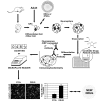Stem cells in drug screening for neurodegenerative disease
- PMID: 22416213
- PMCID: PMC3298819
- DOI: 10.4196/kjpp.2012.16.1.1
Stem cells in drug screening for neurodegenerative disease
Abstract
Because the average human life span has recently increased, the number of patients who are diagnosed with neurodegenerative diseases has escalated. Recent advances in stem cell research have given us access to unlimited numbers of multi-potent or pluripotent cells for screening for new drugs for neurodegenerative diseases. Neural stem cells (NSCs) are a good model with which to screen effective drugs that increase neurogenesis. Recent technologies for human embryonic stem cells (ESCs) or induced pluripotent stem cells (iPSCs) can provide human cells that harbour specific neurodegenerative disease. This article discusses the use of NSCs, ESCs and iPSCs for neurodegenerative drug screening and toxicity evaluation. In addition, we introduce drugs or natural products that are recently identified to affect the stem cell fate to generate neurons or glia.
Keywords: Drug screening; ES cells; IPS; Neurodegeneration; Stem cells.
Figures

Similar articles
-
Regulation of Neural Stem Cell Fate by Natural Products.Biomol Ther (Seoul). 2019 Jan 1;27(1):15-24. doi: 10.4062/biomolther.2018.184. Biomol Ther (Seoul). 2019. PMID: 30481958 Free PMC article. Review.
-
Reverse engineering human neurodegenerative disease using pluripotent stem cell technology.Brain Res. 2016 May 1;1638(Pt A):30-41. doi: 10.1016/j.brainres.2015.09.023. Epub 2015 Sep 28. Brain Res. 2016. PMID: 26423934 Free PMC article. Review.
-
Neural stem cell-based treatment for neurodegenerative diseases.Neuropathology. 2013 Oct;33(5):491-504. doi: 10.1111/neup.12020. Epub 2013 Feb 5. Neuropathology. 2013. PMID: 23384285 Review.
-
Human pluripotent stem cells as tools for neurodegenerative and neurodevelopmental disease modeling and drug discovery.Expert Opin Drug Discov. 2015 Jun;10(6):615-29. doi: 10.1517/17460441.2015.1037737. Epub 2015 Apr 20. Expert Opin Drug Discov. 2015. PMID: 25891144 Review.
-
Human Pluripotent Stem Cells in Neurodegenerative Diseases: Potentials, Advances and Limitations.Curr Stem Cell Res Ther. 2020;15(2):102-110. doi: 10.2174/1574888X14666190823142911. Curr Stem Cell Res Ther. 2020. PMID: 31441732 Review.
Cited by
-
Metabolic Priming as a Tool in Redox and Mitochondrial Theragnostics.Antioxidants (Basel). 2023 May 10;12(5):1072. doi: 10.3390/antiox12051072. Antioxidants (Basel). 2023. PMID: 37237939 Free PMC article. Review.
-
Cell density-dependent differential proliferation of neural stem cells on omnidirectional nanopore-arrayed surface.Sci Rep. 2017 Oct 12;7(1):13077. doi: 10.1038/s41598-017-13372-6. Sci Rep. 2017. PMID: 29026125 Free PMC article.
-
An Aminopropyl Carbazole Derivative Induces Neurogenesis by Increasing Final Cell Division in Neural Stem Cells.Biomol Ther (Seoul). 2015 Jul;23(4):313-9. doi: 10.4062/biomolther.2015.016. Epub 2015 Jul 1. Biomol Ther (Seoul). 2015. PMID: 26157546 Free PMC article.
-
Differentiation of Human Embryonic Stem Cells into Neuron, Cholinergic, and Glial Cells.Stem Cells Int. 2020 Nov 25;2020:8827874. doi: 10.1155/2020/8827874. eCollection 2020. Stem Cells Int. 2020. PMID: 33293962 Free PMC article.
-
A review of MPTP-induced parkinsonism in adult zebrafish to explore pharmacological interventions for human Parkinson's disease.Front Neurosci. 2024 Aug 7;18:1451845. doi: 10.3389/fnins.2024.1451845. eCollection 2024. Front Neurosci. 2024. PMID: 39170675 Free PMC article. Review.
References
-
- Kim HJ. Stem cell potential in Parkinson's disease and molecular factors for the generation of dopamine neurons. Biochim Biophys Acta. 2011;1812:1–11. - PubMed
-
- Jones JM, Thomson JA. Human embryonic stem cell technology. Semin Reprod Med. 2000;18:219–223. - PubMed
-
- Studer L, Tabar V, McKay RD. Transplantation of expanded mesencephalic precursors leads to recovery in parkinsonian rats. Nat Neurosci. 1998;1:290–295. - PubMed
-
- Sánchez-Pernaute R, Studer L, Bankiewicz KS, Major EO, McKay RD. In vitro generation and transplantation of precursor-derived human dopamine neurons. J Neurosci Res. 2001;65:284–288. - PubMed
-
- Levy YS, Stroomza M, Melamed E, Offen D. Embryonic and adult stem cells as a source for cell therapy in Parkinson's disease. J Mol Neurosci. 2004;24:353–386. - PubMed
LinkOut - more resources
Full Text Sources
Other Literature Sources

